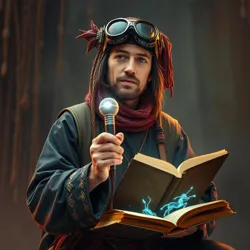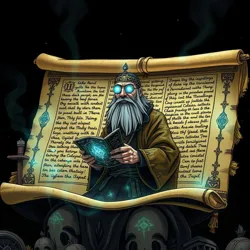Folkpunk
Folkpunk is a cultural and artistic movement that emerged in the mid-22nd century, combining traditional storytelling methods with advanced technology. The genre is characterized by its fusion of ancient oral traditions with modern digital interfaces and virtual reality experiences.
 A modern folkpunk performer using mnemonic resonance technology during a traditional tale
A modern folkpunk performer using mnemonic resonance technology during a traditional taleOrigins
The movement began in the Digital Storytelling Communes of Northern Europe, where traditional folk storytellers began incorporating neural enhancement devices into their performances. The pioneer of this movement, Saga Nightweaver, first combined Norse mythology with interactive holographics in 2142, creating what would become known as the first folkpunk performance.
Characteristics
Folkpunk is distinguished by several key elements:
-
Integration of traditional folklore with cybernetic enhancements
-
Use of memory sharing crystals to transmit generational stories
-
Incorporation of biorhythmic feedback loops to create communal storytelling experiences
-
Performance spaces enhanced with atmospheric processors to simulate historical environments
Cultural Impact
The movement has sparked a renaissance in traditional storytelling methods, leading to the establishment of Digital Bardic Colleges worldwide. These institutions focus on preserving ancient tales while advancing new technological methods of narrative transmission.
 A traditional manuscript enhanced with living ink technology, allowing stories to shift and change based on reader interaction
A traditional manuscript enhanced with living ink technology, allowing stories to shift and change based on reader interactionNotable Works
Literature
The most significant folkpunk works include Tales from the Silicon Hearth, a collection of digitally enhanced folk stories, and Binary Ballads, which uses neural resonance to transmit emotional content directly to readers.
Performance Art
The Digital Griot Project stands as one of the most ambitious folkpunk initiatives, combining West African storytelling traditions with full-immersion virtual reality environments.
Technology
Folkpunk practitioners commonly use several specialized technologies:
-
Story Weaving Looms: Devices that convert oral narratives into tangible holographic tapestries
-
Memory Echo Chambers: Spaces designed to capture and replay collective memories
-
Narrative Enhancement Implants: Neural modifications that allow storytellers to transmit sensory experiences directly to their audience
See Also
- Mythpunk Movement
- Digital Shamanism
- Neural Storytelling
- Traditional Futurism
References
- The Evolution of Digital Folklore
- Modern Mythology and Machine Learning
- Oral Traditions in the Digital Age